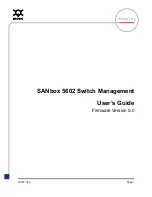
Appendix A
Acronyms
132
Appendix A: Acronyms
ACE
ACE is an acronym for Access Control Entry. It describes access permission associated with a particular ACE ID. There
are three ACE frame types (Ethernet Type, ARP, and IPv4) and two ACE actions (permit and deny). The ACE also
contains many detailed, different parameter options that are available for individual application.
ACL
ACL is an acronym for Access Control List. It is the list table of ACEs, containing access control entries that specify
individual users or groups permitted or denied to specific traffic objects, such as a process or a program. Each
accessible traffic object contains an identifier to its ACL. The privileges determine whether there are specific traffic
object access rights. ACL implementations can be quite complex, for example, when the ACEs are prioritized for the
various situation. In networking, the ACL refers to a list of service ports or network services that are available on a
host or server, each with a list of hosts or servers permitted or denied to use the service. ACL can generally be
configured to control inbound traffic, and in this context, they are similar to firewalls.
AES
AES is an acronym for Advanced Encryption Standard. The encryption key protocol is applied in 802.1i standard to
improve WLAN security. It is an encryption standard by the U.S. government, which will replace DES and 3DES. AES
has a fixed block size of 128 bits and a key size of 128, 192, or 256 bits.
AMS
AMS is an acronym for Auto Media Select. AMS is used for dual media ports (ports supporting both copper (cu) and
fiber (SFP) cables. AMS automatically determines if a SFP or a CU cable is inserted and switches to the corresponding
media. If both SFP and cu cables are inserted, the port will select the preferred media.
APS
APS is an acronym for Automatic Protection Switching. This protocol is used to secure that switching is done
bidirectional in the two ends of a protection group, as defined in G.8031.
ARP
ARP is an acronym for Address Resolution Protocol. It is a protocol that used to convert an IP address into a physical
address, such as an Ethernet address. ARP allows a host to communicate with other hosts when only the Internet
address of its neighbors is known. Before using IP, the host sends a broadcast ARP request containing the Internet
address of the desired destination system.
ARP Inspection
ARP Inspection is a secure feature. Several types of attacks can be launched against a host or devices connected to
Layer 2 networks by "poisoning" the ARP caches. This feature is used to block such attacks. Only valid ARP requests
and responses can go through the switch device.
CC
CC is an acronym for Continuity Check. It is a MEP functionality that is able to detect loss of continuity in a network
by transmitting CCM frames to a peer MEP.
CCM
CCM is an acronym for Continuity Check Message. It is a OAM frame transmitted from a MEP to it's peer MEP and
used to implement CC functionality.
CDP
CDP is an acronym for Cisco Discovery Protocol.
DEI
DEI is an acronym for Drop Eligible Indicator. It is a 1-bit field in the VLAN tag.
DES
DES is an acronym for Data Encryption Standard. It provides a complete description of a mathematical algorithm for
encrypting (enciphering) and decrypting (deciphering) binary coded information.
Содержание GSW-3208M2
Страница 1: ...1 GSW 3208M2 Managed Gigabit Ethernet Switch ...
Страница 144: ...This page is intentionally left blank Date Version Description 2015 8 26 0 9 Preliminary version ...
Страница 145: ......














































